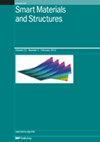Static deformation modeling and analysis of flexure hinges made of a shape memory alloy
IF 3.8
3区 材料科学
Q1 INSTRUMENTS & INSTRUMENTATION
引用次数: 15
Abstract
The flexure hinge is a key element in compliant mechanisms to achieve continuous motion; however the motion range of a flexure hinge is severely restricted by the material’s allowable strain. Due to the superelasticity effect, shape memory alloys (SMAs) can undergo much larger strain than other metals; this means that they are excellent candidates for the fabrication of flexure hinges with a large motion range. In this paper, a simple static deformation modeling approach is proposed for a flexure hinge made of a SMA. The superelastic behavior of the SMA is described by Brinson’s constitutive model. The flexure hinge is considered as a non-prismatic cantilever beam associated with geometrical and material nonlinearities. Govern equations of the flexure hinge are derived and solved numerically by applying the nonlinear bending theory of the Euler–Bernoulli beam. Experimental tests show that the proposed modeling approach can predict the deformation of the flexure hinge precisely; the maximum relative error is less than 6.5%. Based on the static deformation model, the motion capacity, the stiffness characteristic and the rotational error of the flexure hinge are also investigated. The results reveal that the flexure hinge made of a SMA has great potential to construct compliant mechanisms with a large motion range.形状记忆合金柔性铰链静态变形建模与分析
柔性铰链是柔性机构实现连续运动的关键元件;然而,柔性铰链的运动范围受到材料的许用应变的严重限制。由于超弹性效应,形状记忆合金(sma)可以承受比其他金属更大的应变;这意味着它们是制造具有大运动范围的柔性铰链的优秀候选人。本文提出了一种简单的SMA柔性铰链静态变形建模方法。用Brinson本构模型描述了SMA的超弹性行为。柔性铰链是一种具有几何非线性和材料非线性的非棱镜悬臂梁。应用欧拉-伯努利梁的非线性弯曲理论,推导了柔性铰链的控制方程,并对其进行了数值求解。实验结果表明,所提出的建模方法能够准确地预测柔性铰链的变形;最大相对误差小于6.5%。在静态变形模型的基础上,研究了柔性铰链的运动能力、刚度特性和转动误差。结果表明,SMA柔性铰链具有构建大运动范围柔性机构的潜力。
本文章由计算机程序翻译,如有差异,请以英文原文为准。
求助全文
约1分钟内获得全文
求助全文
来源期刊

Smart Materials and Structures
工程技术-材料科学:综合
CiteScore
7.50
自引率
12.20%
发文量
317
审稿时长
3 months
期刊介绍:
Smart Materials and Structures (SMS) is a multi-disciplinary engineering journal that explores the creation and utilization of novel forms of transduction. It is a leading journal in the area of smart materials and structures, publishing the most important results from different regions of the world, largely from Asia, Europe and North America. The results may be as disparate as the development of new materials and active composite systems, derived using theoretical predictions to complex structural systems, which generate new capabilities by incorporating enabling new smart material transducers. The theoretical predictions are usually accompanied with experimental verification, characterizing the performance of new structures and devices. These systems are examined from the nanoscale to the macroscopic. SMS has a Board of Associate Editors who are specialists in a multitude of areas, ensuring that reviews are fast, fair and performed by experts in all sub-disciplines of smart materials, systems and structures.
A smart material is defined as any material that is capable of being controlled such that its response and properties change under a stimulus. A smart structure or system is capable of reacting to stimuli or the environment in a prescribed manner. SMS is committed to understanding, expanding and dissemination of knowledge in this subject matter.
 求助内容:
求助内容: 应助结果提醒方式:
应助结果提醒方式:


